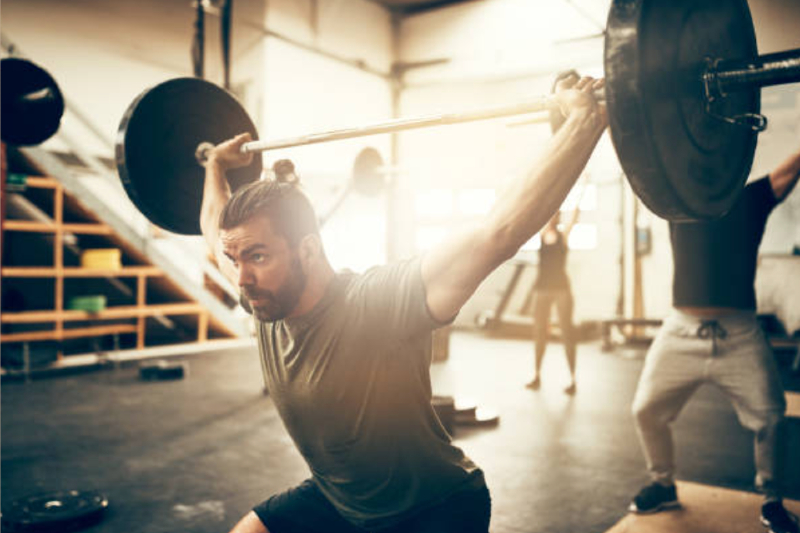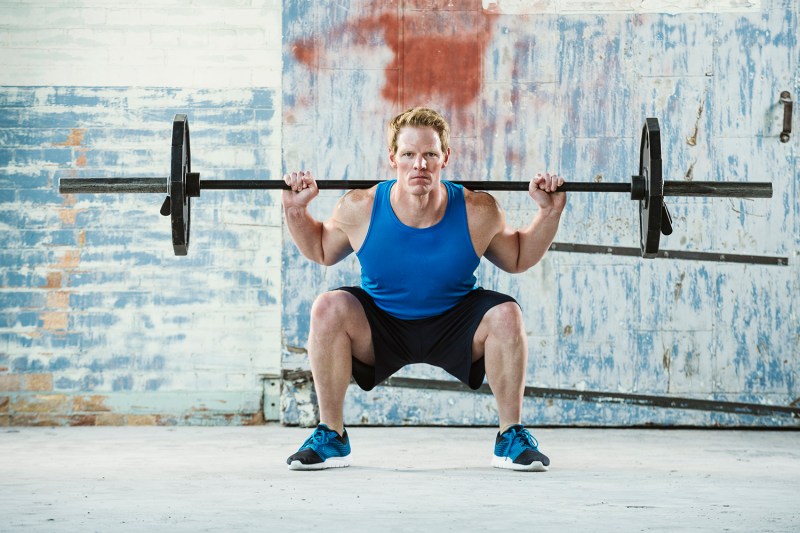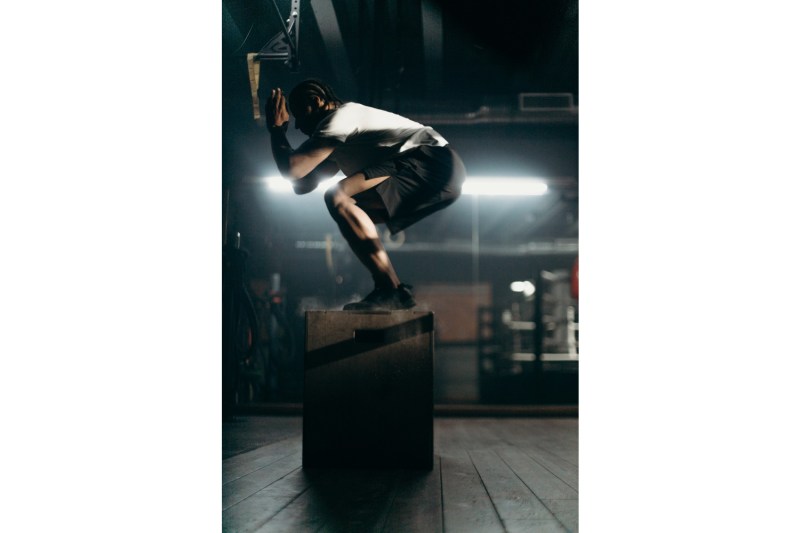You’ve probably heard of several different types of squats, from pistol to sumo and goblet. Squats are a timeless, versatile exercise with many benefits that fire up your legs, glutes, and core and enhance your overall functional fitness. Some squats are better suited for beginners, and others might emphasize your glutes or the quads a little more. Let’s look at the best squat variations to keep your workout routine more interesting and maximize your muscle-building results.
Front squat

The bodyweight front squat is the best place to start if you’re trying to perfect your squatting technique before moving on to other variations. Research shows that you can achieve high levels of activation in your hamstrings, quads, and glutes if you reach the full squat depth where your knees are bent at about 90 degrees and your thighs are parallel to the ground. You can perform the classic front squat with or without weights.
How to do a bodyweight front squat:
- Start standing up with your feet about shoulder-distance apart. Point your toes slightly outward and engage your core.
- Hinge at your hips and bend your knees to lower your body down into a seated position, as if you’re sitting on an invisible chair.
- Lower down until your thighs are parallel to the floor and your knees are above your ankles.
- Avoid arching your lower back and keep your heels and toes on the ground and your chest and shoulders back.
- Hold the pose for as long as you can or for a set duration, such as 30 seconds. Stay focused on proper form.
- When you’re ready, you can push up through your heels and straighten your legs to stand up slowly.
- Repeat until you complete the set.
Barbell back squat

Barbell back squats fine-tune your core stability by working your obliques, erector spinae, and rectus abdominis. This resistance training exercise prompts the release of anabolic hormones like testosterone. Make sure you’ve mastered your squatting technique before attempting the barbell back squat, and avoid going too heavy, which increases your risk of injury. The barbell back squat is recommended for intermediate to advanced lifters.
How to do a barbell back squat:
- Set up the barbell on your upper traps, and make sure it isn’t resting on your neck. Your toes should be slightly angled out with your feet about shoulder-distance apart.
- Engage your core and carefully bring your hips back to lower yourself down into the squat position as if you’re sitting on an invisible chair. Make sure your knees track over your toes.
- Squat down until your thighs are about parallel to the floor. You can go deeper if you’d like, as long as you maintain proper form to perform the movement safely.
- Push through your heels to bring yourself back up to the starting position.
- Repeat until the set is complete.
Overhead squat

Holding a weight above your head during the overhead squat requires more mobility and stability than the basic squat. You’ll improve your core strength, shoulder stability, and more as you maintain the barbell, kettlebell, or medicine ball overhead.
How to do an overhead squat:
- Start standing up with your feet a little wider than shoulder-distance apart and your toes pointed slightly out.
- Hold a ball or barbell up over your head. Make sure you have a wide grip.
- Keep your chest and head up and engage your core.
- Hinge at your hips and bend your knees to sit down into the squatting position.
- Squat down until your thighs are parallel to the floor or as low as you’re comfortable going.
- Push through your heels to return to the starting position.
- Repeat until the set is complete.
Goblet squat

Just like the front squat, your anterior chain muscles on the front of your body are taking on most of the work during the goblet squat. The goblet squat is another excellent move for refining your squatting technique and maintaining an upright torso rather than leaning forward. Holding the kettlebell or dumbbell in front of you also engages your quads a little more, compared to other squat variations, such as the back squat.
How to do a goblet squat:
- Stand with your feet a little wider than hip-width apart.
- Angle your toes slightly outward.
- Use both hands to grip the handles of the kettlebell as if you were a king cupping a goblet.
- Position the kettlebell in the middle of your chest with your elbows bent.
- Keep your core engaged and your spine neutral, and focus straight ahead.
- Bend your knees to dip down into the squat, keeping the kettlebell close to your body.
- Ideally, you want your hips to be parallel with your knees.
- At the lowest point of your goblet squat, your elbows should touch the inside of your knees.
- Press down with the heels of your feet and lift yourself back up to the starting position.
- Repeat until the set is complete.
Bulgarian split squat

The Bulgarian split squat is a single-leg squat variation and a scorcher for your quads. It might also be called the rear-foot elevated split squat. Your legs are in the lunge position, and your back foot is elevated off the ground, resting on some type of bench, sturdy chair, or platform. Holding two moderate to heavy dumbbells at your sides makes this move more demanding and accelerates muscle growth.
How to do a Bulgarian split squat:
- Start by standing in front of a step, chair, or bench facing away from the step with your feet about hips-distance apart. You should be about 2 feet away from the step.
- Lift your right leg and place the top of your right foot on the step.
- Ensure your feet are still about hips-width apart and engage your core.
- Bend your left knee and lower yourself down as if you’re moving down into the lunge position.
- Pause for a moment at the bottom of the movement.
- Drive back up to your starting position with control.
- Repeat for your desired number of reps before switching to the other leg.
Pistol squat

The pistol squat is a more advanced squat variation that requires a greater degree of balance, strength, and mobility. It’s a single-leg bodyweight squat, where you balance your entire body weight on one leg and lower your hips right down to the ground as low as you can. The name describes your body’s pistol shape when you descend into the movement with one leg extended straight out in front of you. You’ll really feel pistol squats in your hip and thigh muscles.
How to do a pistol squat:
- Start standing up with your arms straight out in front of you at shoulder height.
- Shift all of your weight onto your right leg.
- Engage your core and lift your left leg until it’s extended out in front of you at hip height.
- Bring your hips back and start to bend your right knee to lower your body into a squat as if you’re trying to sit down on an invisible chair.
- Keep your right knee centered over your right foot. Your torso can hinge forward slightly.
- Sink down as low as you can until your knee is fully bent and your thigh and calf are touching. Your left leg and hips should be hovering above the floor.
- Press down into your right foot to begin to straighten your right leg and return to the standing position. Your left leg should still be stable and extended throughout the movement. Keep your left leg straight at hip height.
- Repeat until the set is complete.
- Switch to the other leg.
Sumo squat

Sumo squats are the way to go when you want to increase the activation of the adductor muscles in your inner thighs. You’ll also activate your core and lower body muscles to boost your balance and flexibility. The main difference between the basic squat and the sumo squat is the extra wide stance that resembles that of a sumo wrestler. Add a barbell for resistance training once you’ve conquered the bodyweight version.
How to do a sumo squat:
- Start standing up with your feet slightly wider than hip-width apart. Point your toes outward about 45 degrees and rotate your hips outward in the starting position.
- Engage your core and keep your chest upright.
- Push your hips back and lower down into the squat position.
- Press through your heels to return to the starting position.
- Repeat until you complete the set.
Jump squat

The jump squat ramps up your explosive jumping power as you engage fast-twitch muscle fibers. It’s a high-impact strength and conditioning exercise that’ll increase your heart rate and cardiovascular fitness, burn calories, and target your leg and core muscles. You can hold a dumbbell in both hands while performing the jump squat.
How to do a jump squat:
- Drop down into the basic squat position.
- Engage your core and keep your torso upright.
- On your way back up, press through your heels and explode through your toes into a jump.
- Jump up high and land softly before immediately dropping yourself back down into the squat position.
- Repeat until you complete the set.
Squat FAQs

You’ll see exercise enthusiasts performing squats in pretty much any gym you go to. This movement is one of the most efficient ways to amass lower-body muscle power. Read on for your squat questions answered.
Why should you add squats to your training schedule?

The humble squat isn’t just a worthwhile compound strength training exercise; it’s an essential movement pattern used in everyday life by children and people of all ages. You’ll squat and lower your body to sit down from a standing position before rising up to stand again.
You know what they say about skipping leg day; you could end up with beefy upper body strength and disproportionate pencil legs. Adding squats to your training schedule helps you grow muscle in your lower body and target the biggest muscle groups in your legs, including your quads and hamstrings. You’ll also improve your balance, spinal stability, and your ability to bend at your knees.
What muscles are worked during squats?

You’ll engage multiple muscle groups, including:
- Core muscles
- Glutes
- Hamstrings
- Quads
- Hip flexors
- Adductors and inner thigh muscles
- Calves
- Back muscles to stabilize your spine
Which squat variation is best?

The best squat variation for you depends on your goals and current fitness level. If you’re a beginner, starting with a bodyweight front squat is a good idea so you can work on perfecting your squatting technique. When you’ve mastered your form, you can move on to adding weights and trying other variations, such as the goblet squat.
What is the hardest type of squat?

Some squat variations are more advanced than others. For example, adding weights with squats like the goblet squat or the barbell back squat increases the challenge. Squats requiring you to balance more on one leg, such as the pistol squat, are more challenging than the traditional front squat.
Which squat is best for working your legs?

All squat variations will work your leg muscles. Weighted squats like the barbell and goblet squat are killer moves for emphasizing your quads.
Which squat is best for working your glutes?

You’ll increase muscle activation in your glutes with a wider stance squat, such as a sumo squat. Add weights to work those glutes even more. Jump squats target your glutes and refine your explosive jumping power.




